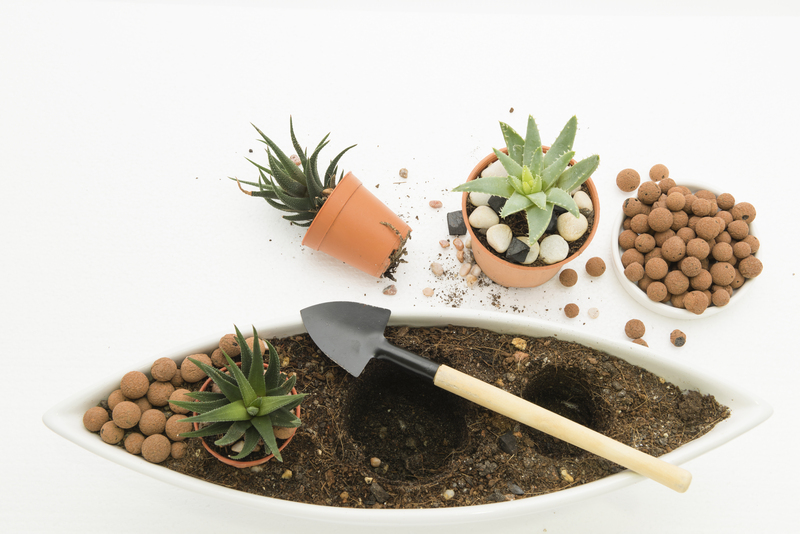Control Weeds Proactively with These Smart Tips
Posted on 20/09/2025
Control Weeds Proactively with These Smart Tips
Want a healthy, vibrant lawn or a productive garden? Proactive weed control is key! Weeds can outcompete your desired plants for nutrients, water, and sunlight, leading to lackluster landscapes and reduced crop yields. Thankfully, you can take charge with these smart, effective strategies to prevent and manage weeds before they become a major problem.
Why Proactive Weed Management Matters
Uncontrolled weeds can quickly take over gardens and lawns, resulting in reduced plant growth, lower yields, and unsightly landscapes. By addressing weeds proactively, you can:
- Save time and effort compared to battling large infestations later.
- Reduce reliance on herbicides and chemical controls.
- Promote stronger growth of flowers, vegetables, shrubs, and lawns.
- Protect the environment and improve overall ecosystem health.
What Does Proactive Weed Control Mean?
Proactive weed control means taking steps to prevent and limit weed growth before they become visible problems. It focuses on early intervention and creating an environment that discourages weeds, making long-term management easier and more effective.

Top Smart Tips to Control Weeds Proactively
-
Use Mulch Generously
Mulching is one of the easiest and most effective ways to block weed growth. Apply a layer of organic mulch--like wood chips, straw, compost, or shredded leaves--around your plants and over bare soil. Mulch:
- Suppresses weed germination by blocking sunlight
- Regulates soil temperature and moisture
- Improves soil structure as it decomposes
- Reduces the need for herbicides
-
Practice Dense Planting
Grow flowers, vegetables, and groundcovers tightly spaced to create a dense canopy, minimizing bare soil where weeds can take hold. Strong competition from desired plants prevents most weeds from establishing.
Consider using low-growing groundcovers in garden beds and landscaping. Some excellent weed-suppressing options include creeping thyme, clover, vinca minor, and ajuga.
-
Stay Ahead with Regular Weeding
Don't wait until weeds take over! Make regular, quick weed patrols part of your gardening routine. Focus on:
- Hand-pulling small weeds before they go to seed
- Using a hoe to disturb weed seedlings after rain
- Removing entire roots of perennial weeds
-
Prevent Weeds from Going to Seed
One year's seeding means seven years' weeding! Don't let even a single weed flower or seed in your garden.
- Cut or pull weeds before they bloom
- Dispose of weed debris away from your garden
- Keep fence lines, borders, and compost piles weed-free
-
Employ Weed Barriers and Landscape Fabric
Physical weed barriers such as landscape fabric, cardboard, or thick layers of newspaper block sunlight and keep weeds from emerging. Use these under mulch in pathways, flower beds, or vegetable gardens for extra protection.
Remember: Over time, some aggressive weeds may find a way through, so regular checks are necessary.
-
Water Wisely
Targeted irrigation methods like drip lines or soaker hoses direct water to your crops or landscape plants only. By keeping soil between rows dry, you reduce weed germination.
Practice early morning watering to maximize uptake by desired plants and discourage weed growth.
-
Maintain Healthy Soil
Healthy soils lead to healthy plants that outcompete weeds naturally. Regularly amend your soil with compost, cover crops, and appropriate organic fertilizers to maintain structure and fertility.
Test your soil every few years to check pH and nutrient levels, allowing you to tailor amendments to your garden's needs.
-
Cultivate with Care
Routine cultivation can unearth buried weed seeds and encourage germination, so disturb soil only when necessary. Instead of deep tilling, opt for shallow hoeing and targeted disturbance.
Consider a no-till gardening approach that leaves soil structure intact and weed seeds buried.
-
Use Cover Crops and Green Manures
Planting cover crops such as rye, clover, or vetch during the off-season or between crop cycles helps suppress weeds, fix nutrients in the soil, and improve organic matter.
- Winter covers protect soil and outcompete cool-season weeds.
- Summer covers fill in gaps and add biomass.
-
Promote Lawn Health to Prevent Weeds
To control weeds proactively in lawns, focus on turf health:
- Mow at the right height for your grass type (usually 2.5 to 3.5 inches).
- Avoid scalping, which allows sunlight to reach weed seeds.
- Feed your lawn with appropriate fertilizer and maintain soil pH.
- Aerate compacted areas and overseed bare patches in fall.
Advanced Weed Prevention Techniques
Solarization
For weedy or new garden beds, solarization uses clear plastic sheeting to trap solar heat and kill weed seeds and soil pathogens. Here's how:
- Water the soil deeply, then cover with clear plastic for 4-6 weeks during hot, sunny weather.
- Edge the plastic with soil to prevent heat loss.
- After removal, plant immediately or cover with mulch.
Flame Weeding
Flame weeders use targeted heat to kill young weeds in pathways, driveways, or between plants. Pass the flame quickly over weed foliage to wilt and destroy it. Use caution and check local fire restrictions.
Homemade and Organic Herbicides
Natural or organic herbicide sprays (like vinegar, soap, and salt mixtures) can be used for spot treatments. While safer for the environment, these are typically non-selective and may need repeated applications. Always test on a small area first and avoid spraying desirable plants.
Are Chemical Herbicides Ever Needed?
Sometimes, severe or persistent weed infestations may require targeted use of chemical herbicides. Use these as a last resort and always:
- Read and follow label directions carefully
- Avoid spraying on windy days to prevent drift
- Spot-treat only affected areas
- Choose the least toxic option available
Understanding Weed Life Cycles
Different weed types require different proactive controls:
- Annual weeds (e.g., crabgrass, chickweed): Complete their life cycle in one year. Prevent them from seeding by early removal and mulching.
- Perennial weeds (e.g., dandelion, bindweed): Live several years and regrow from roots. Dig out roots completely. Persistent monitoring is crucial.
- Biennial weeds (e.g., burdock, thistle): Grow leaves the first year and bloom/seed the next. Remove before flowering in the second season.
Common Mistakes to Avoid in Weed Management
- Ignoring early signs of weed growth or waiting until it's out of control
- Letting weeds flower and seed, increasing future problems
- Improper use of mulch or failing to replenish it
- Over-tilling the soil, exposing buried weed seeds
- Overwatering and promoting weed seed germination
- Spraying non-selective herbicides carelessly, damaging desirable plants

Conclusion: Win the War on Weeds with Proactive Control
Proactive weed management is your best strategy for a weed-free and flourishing landscape. Start with healthy soil, cover bare ground, stay vigilant with regular checks, and integrate smart planting and maintenance habits.
Combining these smart weed control tips will:
- Reduce the work and chemicals needed long-term
- Improve your garden's productivity and appearance
- Boost the vigor of turf and ornamental plants
Frequently Asked Questions on Proactive Weed Control
- What is the most effective method to stop weeds from germinating?
Applying mulch to bare soil and using dense plantings are among the most effective methods to prevent weed germination. - How often should I weed my garden?
Check your garden at least once a week during the growing season. Frequent, small efforts prevent larger weed issues. - Can I compost weeds I pull?
You can compost weeds if they haven't gone to seed or flowered. Otherwise, dispose of them to avoid spreading weed seeds. - Do organic or homemade weed killers really work?
Organic sprays can be effective for spot-treating young weeds, but are usually less potent than synthetic herbicides.
Take Action Today for a Weed-Free Tomorrow
Start implementing these smart, proactive strategies to stay ahead of weeds all season long. With consistent effort and the right mix of methods, you can enjoy lush, healthy, and weed-free gardens and lawns year after year.



